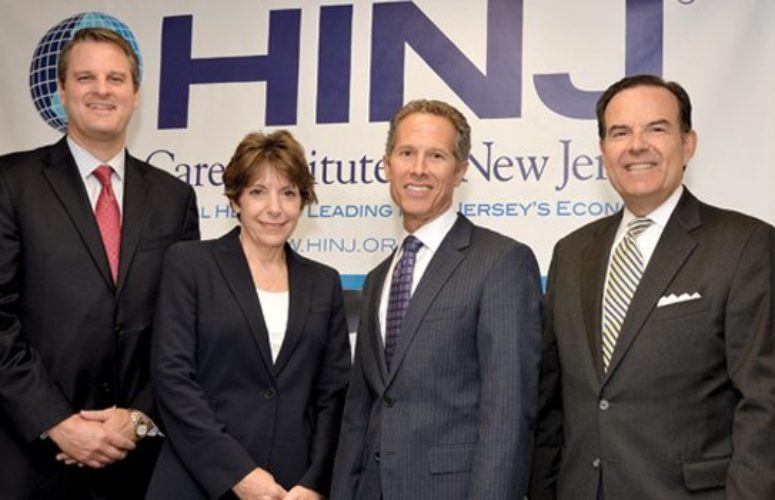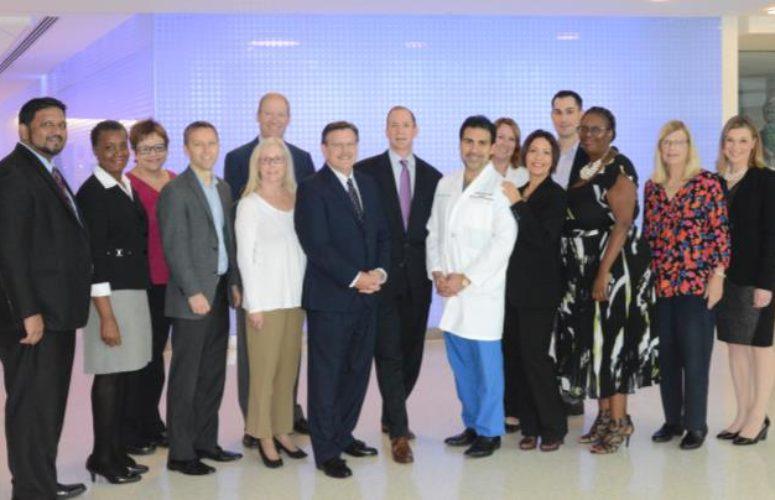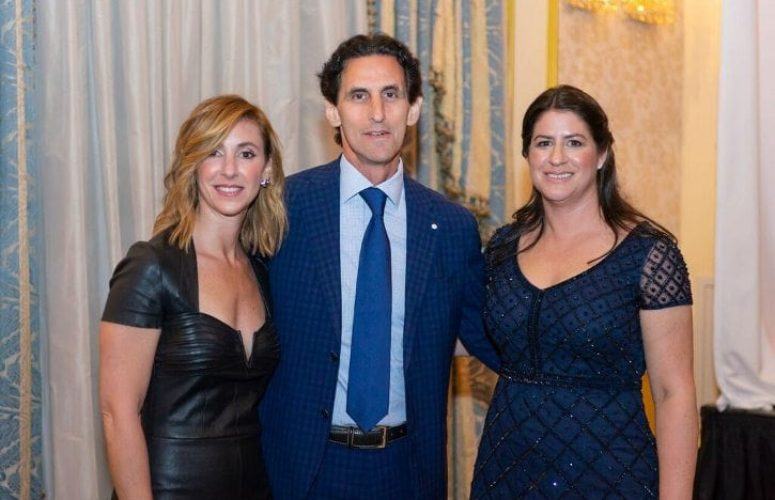
HealthCare Institute of New Jersey Roundtable
In tandem with cutting-edge scientific advances, the biopharmaceutical and medical device sector faces an array of challenges.
By George N. Saliba, Managing Editor On Nov 10, 2014While biopharmaceutical and medical device companies face challenges including patent expirations and regulatory hurdles, science is nonetheless advancing at an astounding rate. Researchers continue to unlock the potential of the human genome (which results in novel therapies), and, moreover, treatments combining medical devices and medicines continue to be an impressive reality. New Jersey Business magazine, in cooperation with the HealthCare Institute of New Jersey, recently interviewed four life sciences executives about both the hurdles – and opportunities – their sector is now addressing, and what it all means for New Jersey, a state long termed “The Medicine Chest of the World.” Their answers, which comprise this next installment of New Jersey Business magazine’s Trade-Talk Roundtable series, can be found on the following pages.
Our magazine would like to thank the HealthCare Institute of New Jersey, especially President and CEO Dean Paranicas and Director of Communications Douglas Berger, for hosting us at the association’s New Brunswick headquarters, and for helping us assemble this panel.
Participants in this discussion are:

Dr. Bruder is a magna cum laude graduate of Brown University and CWRU School of Medicine. He obtained further clinical training at Albert Einstein Medical Center and the University of Pennsylvania.


Prior to her current role, Licitra was Worldwide Chairman, Global Medical Solutions Group within Johnson & Johnson’s Medical Device and Diagnostics segment. In that role, she was responsible for setting the strategy and vision for a global portfolio of Johnson & Johnson’s healthcare companies including Vision Care, Diabetes Care, Ortho Clinical Diagnostics, and Advanced Sterilization Products, as well as the Sedation business unit. Licitra has had a nearly 30-year career in healthcare at Johnson & Johnson.

Prior to joining HINJ, Paranicas was vice president, corporate secretary and public policy, for BD. Starting at BD in 1981, he previously served in various legal roles at the company, and also as: director, corporate development and strategic investments; director, investor relations; and as vice president, investor relations and public affairs.
Paranicas began his career as an associate attorney with McCarter & English, LLP in Newark. He earned a B.A. Degree With Honors from Rutgers College, Rutgers University. He earned a J.D. degree from Rutgers-Newark School of Law, where he was an editor of the Rutgers Law Review.
Paranicas previously served as HINJ’s Board Secretary and Chair of its Steering Committee.
Q: The life sciences sector has been facing a patent cliff, with numerous blockbuster, profit-generating drug patents expiring. How serious is this issue, and what are biopharmaceutical companies doing to address it?
Paranicas: This is an industry that is innovation-driven and focused, and, as result, we are constantly, relentlessly pursuing new medicines, therapies, technologies and devices. Of course, when we do that, we are always looking to create intellectual property – and to protect it. One form of protection that is a critical element across the entire spectrum are patents. But, patents have a lifecycle to them. It is part of what I would call a “virtuous” cycle: We create intellectual property, we seek to protect it, and we then develop it in order to help patients with new medical advances. In turn, we constantly seek to replenish it and renew. We just continue to work through it.
Licitra: The one good thing – if there is anything good about patent expiration – is that you know when it is coming and you plan for it. That’s what biopharmaceutical companies are doing, now. In fact, I think many companies are moving away from the traditional blockbuster-type drugs, and moving to focus on more rare diseases that are more challenging to solve, but also have a great unmet need. Companies are focusing on key areas. For example, at Johnson & Johnson, we have selected the areas in which we are going to focus, such as oncology, immunology or infectious diseases, for example. We are putting all of our efforts into going deep within those areas. That requires us to expand our horizons outside the four walls of our building, and make sure that we are collaborating – partnering – with the best science and engineering that’s out there. Quite honestly, I think it is paying off. We might need to redefine what “blockbuster” means these days: It might not be the multi-billion-dollar-type drugs that we’ve had in the past. The fruits of our efforts recently are delivering life-saving, and quality-of-life-saving drugs, for patients.
Casserly: Between 2012 and 2016, the top-branded pharmaceuticals are going to have a patent cliff that will have an estimated $117 billion of US sales. For the top-selling drugs, once generics hit the market, they are going to capture most of the market share. But, to build on what Dean said, this is how the lifecycle of drugs has been set up. You have the research and development, in which you take the risk. You hopefully bear the rewards of recouping your research and development, and then lower-cost drugs are there to benefit the public. For Novartis, knowing this is the lifecycle of the drugs, last year we invested 17 percent of our net sales back into R&D (approximately $10 billion). However, we know that is not enough. We have to work smarter. We are looking at smart productivity. What does this mean? For us, this means looking earlier in the clinical development stage – in the proof-of-concept phase. What we are looking at is modeling science and biology. Through this, we have been able to cut our proof-of-concept clinical trials by half. This helps us get more predictability, as far as picking those compounds that we believe have a better chance of being viable and successful in the marketplace. We are trying to learn as much as we can earlier in the process.
Q: “Traditional” pharmaceutical companies are now acquiring biotechnology companies. Why is this occurring, and how does it affect traditional pharmaceutical companies?
Casserly: There are really two primary reasons why you are seeing acquisitions of smaller biotech companies. The first one is what we mentioned in the first question: There is a lot of patent cliff for a lot of companies’ top-branded drugs going generic, and acquisitions can be a way to replenish their pipelines. The second reason is that, regardless of the size of the company, a company cannot be everything to all parts of medical science and innovation. When you have biotech companies, they tend to be niched in their technology, their assets and their focus. When you are exploring them, they could either be complimentary, or a new area in which a big pharma company would like to go. Rather than start from scratch, this is a way for you to acquire those assets, as far as people, talent and where the companies are in their clinical development.
Licitra: It is very similar to the med-tech industry’s strategy for many years. We have always acquired the smaller, start-up company. It may not be the perfect analogy, but we have always done it to enhance our product line, or to get into a complementary space, without having to develop it all from scratch. That’s what the pharmaceutical companies are starting to realize: In order to solve a lot of the big, unmet needs and problems, they are going to have to look outside their own laboratory walls and bring in new science, new capabilities and new thinking.
Paranicas: This is particularly true when you think of it relative to traditional, chemistry-based pharmaceutical development, versus protein- and cell-based, which is the biotechnology companies’ sphere. It is another facet of the same stone, when we talk about collaboration. Historically, we collaborated, or our companies acquired other companies. There have been various relationships that yield these important outcomes, and, certainly, acquisitions is one aspect of those.
Q: On a related note, how has the relationship evolved between large and small medical technology companies, and between med-tech and biopharmaceutical companies?
Bruder: I would say here at Stryker, like many other larger companies, we are continuously scanning the horizon for early-stage smaller companies, mid-stage and later-stage, smaller companies, that are in various places in their maturation toward product approval and commercialization. Clearly, what we are looking for are those that have high-impact innovation opportunities, and the kinds of things that we would not necessarily organically develop from scratch inside the company. We’re going to continue to pay attention to this. However, if you look around the sector overall, there are signs of ongoing consolidation. What you’ll see is smaller companies filling a niche for other companies, to either deepen the service-line offering, in a particular therapeutic area, or to expand their footprint into adjacencies, such that they get an accelerated entry, without having to create that from scratch. More strategic partnerships and acquisitions are surely on the horizon, for Stryker and other companies like us, here in New Jersey.
Licitra: I think we are also going to see this not just within our own sector. So, yes, pharma to biotech, biopharma to biotech, and big medical device to small medical device … but, even between pharmaceutical companies and medical device companies. Combination products are going to be some of the exciting innovations to come, as we look to solve some of the problems in healthcare, today, whether it is from a disease perspective, or even on the commercial side of our business. We have technologies today that bring a device along with a drug. We finally got approval this year [for a combination product]. And that is tough, because in order to bring combination products to market, getting through the FDA is one issue that still needs a lot of regulatory pathway work. However, you are seeing a lot of these technologies, now, come together, that offer great opportunities to treat diseases or lower the cost of care.
Bruder: There are opportunities for drug/device combinations to evolve. In fact, the agency (FDA) created this office of combination products in 2002. Between that period and 2009, there were an increasing number of submissions for product approvals. What’s interesting is if you go back now and look: Since 2009, the number of submissions has gone down in the combination approvals. Personally, I think that’s because of the complexity that you (Licitra) refer to … and the cost that is associated with that. For a device company, the cost of delivering a combination product that contains either a pharmaceutical or a biologic far exceeds that to which they are accustomed. If you are a pharmaceutical company, you are used to spending a billion dollars to get something through the pathway. So, we are seeing fewer approvals. Having said that, I will tell you what I am very excited about is this convergence between healthcare, IT enablement, information – and that combination with medical devices.
Casserly: I think where [Dr.] Scott [Bruder] was going, is reaching outside the life science industry. Novartis’ eye-care division – Alcon – recently did an agreement with Google, for a smart contact lens. And this is going to do two things: One, it is going to measure glucose levels by looking at the tear fluid in the eye, and that is going to connect to a mobile device for diabetic patients. The second thing it is going to do – for those who need reading glasses – is potentially help the eyes’ natural auto-focus. These are the new technologies and new partnerships that we are going to be working with outside the traditional pharma, or pharma with medical device companies.
Q: As scientists further comprehend the sequencing of the human genome, how does this affect the life sciences sector? And how will your sector increasingly become a part of this scientific breakthrough?
Licitra: It is just incredibly exciting to think that scientists can better map the human genome, or any kind of diagnostic that truly helps a physician reach the ultimate goal. And it is about the right drug at the right dose, at the right time, for the right patient. You can really customize a treatment to a particular person’s lifestyle, or demographics, or whatever it is – their genetic makeup is – that either causes them to be pre-disposed, or have that disease.
Casserly: Much like Johnson & Johnson, Novartis is also aiming to identify the right patient with the right drug, at the right time. It’s the personalized medicine philosophy. We believe that, traditionally, medicines have always been developed with a one-size-fits-all [mentality]. We are now seeing data that shows that for up to 50 percent of the patients who are taking their medicines, the medicines are not acting as effectively as they should. This validates the need for where the science is going: To look at a more targeted approach in our research and development technologies. Going to your point of moving to understand the human genome and advances in biology, and advances in computer science – we gave examples earlier. There’s just unprecedented analysis of the human genes and proteins. This knowledge is going to help us build these targeted, customized therapies that are going to enable doctors to prescribe medicines that are going to be more individualized for the patient.
Bruder: This creates a dilemma for the pharmaceutical industry, from my vantage. As this explosion of information and analytics becomes available, you can then refine and subdivide patient populations into those who will be responsive to compound X, Y or Z. And with the advent of early markers, and the ability to identify those patients that can respond, you have a higher likelihood of getting approval through the FDA. However, it limits the number of patients that you can treat with any given compound. The dilemma is that you need to find ways to reduce the expenses associated overall with the development of these drugs, because we can’t afford, as a society, to spend billions of dollars on coming up with solutions that are only treating smaller patient populations.
Paranicas: In that respect, it is analogous to what the situation is with the rare disease population. You’ve got a smaller, addressable patient population, but there is a cost to developing these drugs and devices. It doesn’t matter what size your patient population is, there is a certain investment that you need to make, in order to achieve those outcomes.
Q: The Affordable Care Act (ACA) has wide-ranging impacts for nearly every American. To what extent does it affect your sector? And I am talking here about innovation, patient access, payment systems – everything is changing.
Licitra: First of all, Johnson & Johnson supports the ACA, meaning we believe that all patients should have access to affordable, quality healthcare. However, any kind of new reform out there, from a healthcare perspective, creates both opportunities and challenges. Outcomes and lowering the cost of healthcare are what are going to get rewarded through the ACA. It really challenges us to think about how are we delivering products to market: Are they truly delivering the outcomes? I grew up on the device side for 30 years, and it was always the features and benefits. That’s what you sold to a clinician. Today, that’s not the case. That clinician, although still an important part of the decision-making body, is not the only decision maker. Companies have to create value dossiers for their product or services, that explains this is why this product, with these features, will do better for patients.
Bruder: We at Stryker also support the initiatives of the ACA. Our goal is to drive innovation forward, while at the same time reducing the total cost of healthcare, like Karen said. In fact, when you ask about how the ACA has impacted innovation, I can give two examples. From an organic standpoint, we are looking at products that can reduce the incidents of bedsores, for inpatients – products that reduce the likelihood of patients actually falling out of bed. These are called “never events,” for which the complications are not reimbursed. For example, if a patient falls out of bed and has a complication, that becomes an enormous burden to the hospital. We want to try to prevent that, and we are investing to drive that. At the same time, we are also looking at acquisitions, and we recently completed an acquisition of a company called Patient Safety Technologies, that has the ability to count sponges that are used in surgical procedures, to ensure that no foreign bodies are left in the patient, after the surgery. A retained foreign body is also considered a “never event,” and complications that result from that can reach into the hundreds of thousands of dollars. If you think about how this is changing the way companies drive innovation, it has had an immediate impact.
Paranicas: The other thing here is you look at the overall framework of the ACA – the fact that there’s an addition [regarding] the focus on outcomes in terms of reimbursement. That expresses itself in a variety of ways, whether it is patient-centered outcomes research [or] comparative effectiveness research … different approaches that are all calculated to measure results in terms of being effective. Another key element of it, of course, is that you have preventive programs that are an important part of it. Now, prevention, wellness and chronic disease management are critical.
Casserly: We’re clearly at a critical, pivotal point for the US healthcare system, with the implementation of the ACA. Regardless of the political views of the ACA, it is important that policymakers, business leaders and providers get together and try to address the patients’ needs, and make sure that we are able to figure out ways to lower costs and improve healthcare outcomes.
Q: What impact is the ACA’s medical device tax having on your sector, at this point?
Bruder: Stryker, and companies like us, are significantly concerned with the medical device tax, and its impact on the ability to drive innovation and job growth. This is a $30-billion sales tax, and it is not based on profit, but rather top-line sales. It impacts not only large companies, but the small companies, too, that feel it much more dramatically. Consequently, it compromises their ability to drive innovation and investment. If you look at a recent industry survey, [the medical device tax] has resulted in the loss of about 14,000 jobs, and the foregone hiring of 19,000 jobs, leading to a net decline of about 33,000 jobs, to date. It is particularly troubling, because this tax liability basically undermines the ability to invest, therefore preventing the possible development of longer-term solutions. It creates a vicious cycle, compared to a virtuous cycle, to which Dean previously referred. To put it in perspective, at a company like Stryker, this is going to cost us about $100 million this year, which is a full 20 percent of our R&D investment.
Licitra: From Johnson & Johnson’s perspective, we have a huge medical device business, but, again, we support the ACA, and we’ve taken the position that we have to be able to pay our fair share to expand coverage. We want to make sure, though, that whatever is done in the industry to help pay for this, it doesn’t impede innovation and access of innovation for patients. Also, we talked before about how medical device companies rely on the small, start-up companies; the companies that have innovative products that you either want to complement your product with, or provide a new space that you add to your product line. We get concerned that the medical device tax could impact the startups.
Paranicas: Let me just add, from the trade association perspective, that HINJ has supported efforts to repeal the tax – for the reasons that have been expressed by Karen and Scott – and, certainly, given the fact that innovation is such a critical aspect of what we do, it has that impact that has been described, and particularly in the smaller companies, because many of them are not yet profitable.
Q: New Jersey is considered the “Medicine Chest of the World,” and there has been a lot going on, with some key companies leaving. How will New Jersey retain its leadership position? What is the state doing to help attract and retain industry investment, here, in a hyper-competitive, global landscape?
Paranicas: Well, first of all, not only are we proud that New Jersey is considered the medicine chest of the world, but we intend to keep it that way. Certainly, we are doing everything we can in working with our member companies, and with our elected officials in Washington and in Trenton, to do just that. We have to acknowledge the reality that this is an intensely competitive landscape in which we are operating, in terms of other states and countries in geographic regions that are pursuing, very aggressively, life sciences investment for all of the many positive benefits that the life sciences industry provides, in terms of jobs and economic impact. And, of course, overall, the benefits we provide in terms of advancing human health. When you look at that, you are confronted with an environment in which every day that goes by, we are constantly competing. However, I am an optimist about this, and I am enthusiastic about it because when you look overall at what’s been happening, we’re advancing and making strong progress.
To elaborate, while there have been some reductions in companies that have been leaving the state, there have been many important examples of significant investment in the state, that has been represented by all of the companies that are here at the table, and many others. Why is that? We have an extremely educated and talented workforce, because we’ve got an infrastructure that is very strong, and we have a strengthening educational environment with our research universities. There are areas where progress has been made. Again, this goes back to what our elected officials, particularly in Trenton, have been focusing on. The governor and the Legislature have responded in what we would like to call a “New Jersey business environment 2.0.” They have addressed a lot of tax issues affecting our industry. They have addressed and tried to respond to issues involving regulatory processes and red tape challenges, which make it more difficult to do business here. The [state’s] business incentive programs have been streamlined. Just as important is the fact that higher education restructuring promises to provide a tremendous boost, in terms of combining Rutgers University and the former University of Medicine and Dentistry of New Jersey. Designating Rowan University as a research university, to grow the higher education community in the southern part of the state [is also key]. This is all part of what we call the innovation ecosystem. The innovation ecosystem is that partnership between the academic community, the business community and state government. It’s how they work together and interact to create a robust environment that addresses the needs of our companies and make them want to invest more, do more research here and do more clinical trials here. When you put all those together, you are seeing what I consider to be a very positive trend, in terms of the amount of investment, the new companies coming in – I could enumerate any number of examples, if you’d like. Suffice it to say, there has been a lot of forward progress in the last couple of years.
Related Articles:





